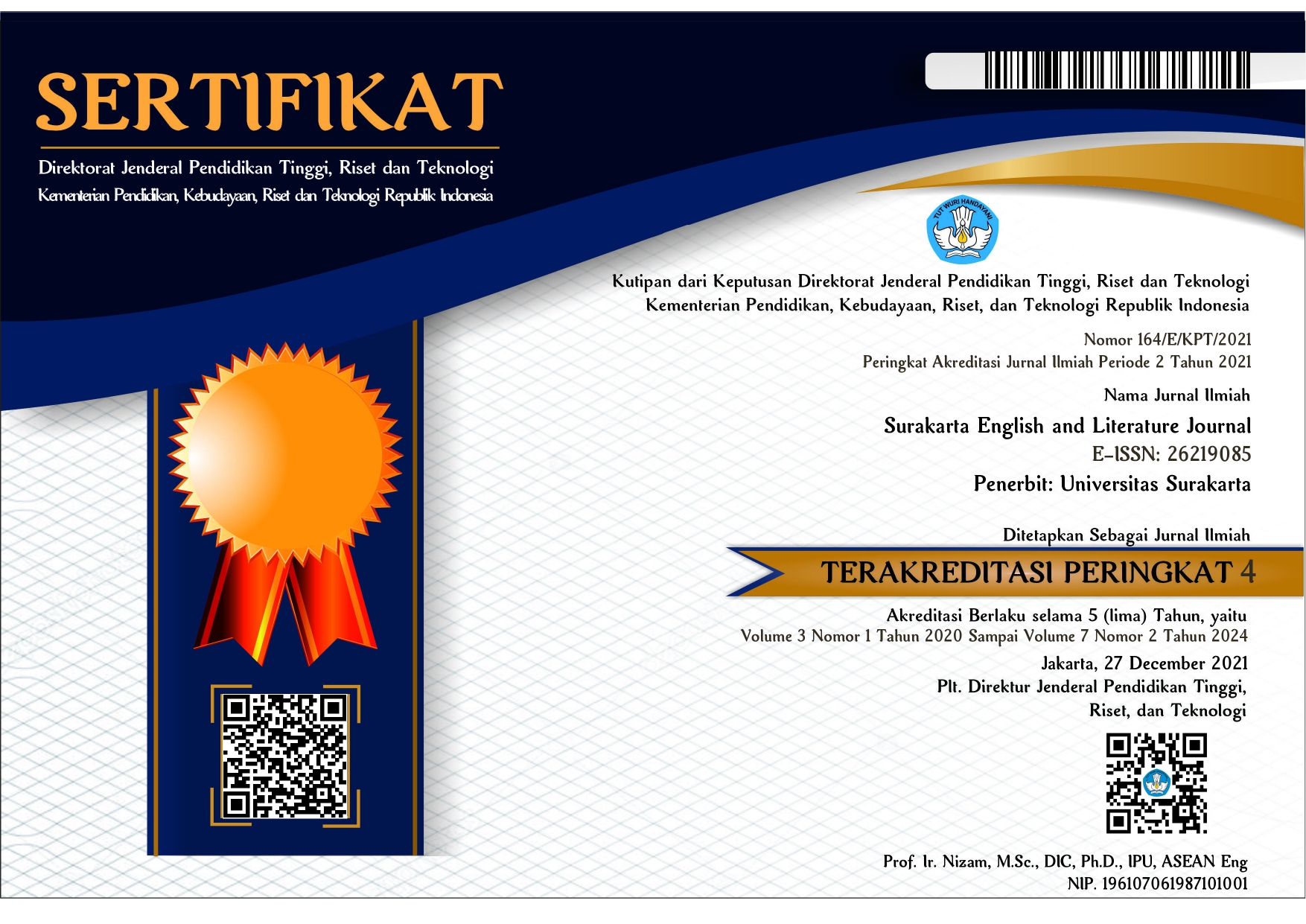Efferent Reader Response Study on Adrian Lyne’s Lolita Movie
DOI:
https://doi.org/10.52429/selju.v7i2.234Keywords:
Efferent Reader Response, Themes, Movie, MoralAbstract
This study examines reader responses to a Lolita movie by Adriane Lyne based on the problem of how people interpret and retain pros and cons in the movie. How viewers' moral frameworks and ethical considerations influence their reader responses to the moral themes depicted in the movie "Lolita." How viewers’ perceptions of the characters, themes, and events in “Lolita” influence their efferent responses to the movie. This study applies the efferent reader response theory by Louise Rosenblatt. The data of this research consists of several comments and opinions of the viewer of the Lolita movie directed by Adrian Lyne that discussed the contradiction between the theme of pedophilia and its cinematography. The primary data are collected from the sources around the reader's opinion of the movie. Meanwhile, secondary data are obtained from other resources, such as related previous studies, journals, and other sources. Data collection are accomplished through the use of document analysis.The audience's reaction to Lyne's "Lolita" was divided, with 113 out of 173 approving it as a significant adaptation for its novel authenticity and quality, while 60 criticized it for its explicit and provocative portrayal of relationships, deeming it too far from the original novel while Viewers' moral attitudes significantly impact their understanding of Lyne's "Lolita," which questions society conventions and ethical standards by addressing controversial topics like as knowledge, exploitation, and the complexity of human sexuality.
References
Cahyaningrum, I. O. (2018). Psychological Literature Translation. Surakarta English and Literature Journal (SELJU), 1(1), 31. https://doi.org/10.52429/selju.vlil.205
Eaton, A. W. (2015). Literature and Morality. In The Routledge Companion to Philosophy of Literature (pp. 433–450). Routledge.
Fish, S. (1980). Is There a Text in This Class?: The Authority of Interpretive Communities. Harvard University Press.
Gert, B., & Gert, J. (2020). The Definition of Morality. In E. N. Zalta (Ed.), The Stanford Encyclopedia of Philosophy (Fall 2020). Metaphysics Research Lab, Stanford University.
Haddad, L. M., & Geiger, R. A. (2023). Nursing Ethical Considerations. StatPearls.
Herlihy, J. (1993). Paedophilia, child sexual abuse and practical approaches to prevention. Australian Institute of Crimonology.
Herlihy, J. M. (1993). Paedophilia, child sexual abuse and practical approaches to prevention. Australian Institute of Criminology.
IMDb. (2024). What is IMDb? IMDb.Com. https://help.imdb.com/article/imdb/general-information/what-is-imdb/G836CY29Z4SGNMK5?ref_=helpart_nav_1#
Lehman, P., & Luhr, W. (2018). Thinking about Movies. Watching, Questioning, Enjoying.
Lestari, A. (2019). An Analysis on Intrinsic and Extrinsic Elements of Sir Arthur Conan Doyle’s “The Adventure of Sherlock Holmes.” Muhammadiyah University of Purwokerto.
Nurhandayani, K. (2014). An Analysis of Themes and Sub-themes in Judy Blume’s Are You There God? It’s Me Margaret. Yogyakarta State University.
Perrotta, G. (2020). Pedophilia: Definition, Classifications, Criminological and Neurobiological Profiles, and Clinical Treatments. A Complete Review. Open Journal Pediatricks and Child Health, 5(1), 019–026. https://dx.doi.org/10.17352/ojpch.000026
Plevikova, I. (2016). Lolita: A Cultural Analysis. Masaryk University.
Pravitasari, S. G., Octaviani, S. K., & Arumsari, A. (2021). Error Analysis on the Students’ English Speech of STMIK Sinar Nusantara. Surakarta English and Literature Journal (SELJU), 4(1). https://doi.org/10.52429/selju.v4il.563
Putri, D. A. A. K. (2020). Pedhopilia in Adrian Lyne’s Lolita Movie (1997): An Audience Response by Gender. Universitas Muhammadiyah Surakarta.
Ratna, L. (2020). Vladimir Nabokov’s Lolita: The Representation and the Reality Re-Examining Lolita in the Light of Research into Child Sexual Abuse. IOSR Journal of Humanities and Social Science.
Robson, M. (2020). What is Literature? A Critical Anthology.
Rosenblatt, L., M. (1978). he Reader, the Text, the Poem: The Transactional Theory of the Literary Work. Southern Illinois University Press.
Sadjadi, B. (2017). Reader-Response Approach: Critical Concepts and Methodology in Phenomenological Reading Theory. Reading Research Journal, 1(1).
Schnell, J. (1990). A Comparison of Aesthetic and Efferent Reading Strategies of College Students.
Seto, M. C. (2009). Pedophilia. Annual Review of Clinical Psychology.
Tamrin, A. F., Basri, & Putri, A. E. (2023). The Response of Readers in the Novel The Call of The Wild. Surakarta English and Literature Journal (SELJU), 6(2). https://doi.org/2621-9077
Taylor, S. J., Bogdan, R., & DeVault, M. L. (2016). Introduction to Qualitative Research Methods: A Guidebook and Resource (4th ed.). John Wiley & Sons, Inc.
Walker, A., David, A. M., & Amber, L. M. (2016). Finding Lolita: A Comparative Analysis of Interest in Youth-Oriented Pornography.
Wolak, J., Finkelhor, D., J. Mitchell, K., & Ybarra, M. (2008). Online “Predators” and Their Victims: Myths, Realities, and Implications for Prevention and Treatment. American Psychologist.
Zabalbeascoa, P. (2016). Title: Censoring Lolita’s sense of humour: When translation affects the audience’s perception PREPRINT. Tudies in Translatology.
Downloads
Published
How to Cite
Issue
Section
License
Copyright (c) 2024 Yolanda Tesalonika Danta

This work is licensed under a Creative Commons Attribution-ShareAlike 4.0 International License.
Licensing for Data Publication
-
Open Data Commons Attribution License, http://www.opendatacommons.org/licenses/by/1.0/ (default)
-
Creative Commons CC-Zero Waiver, http://creativecommons.org/publicdomain/zero/1.0/
-
Open Data Commons Public Domain Dedication and Licence, http://www.opendatacommons.org/licenses/pddl/1-0/














